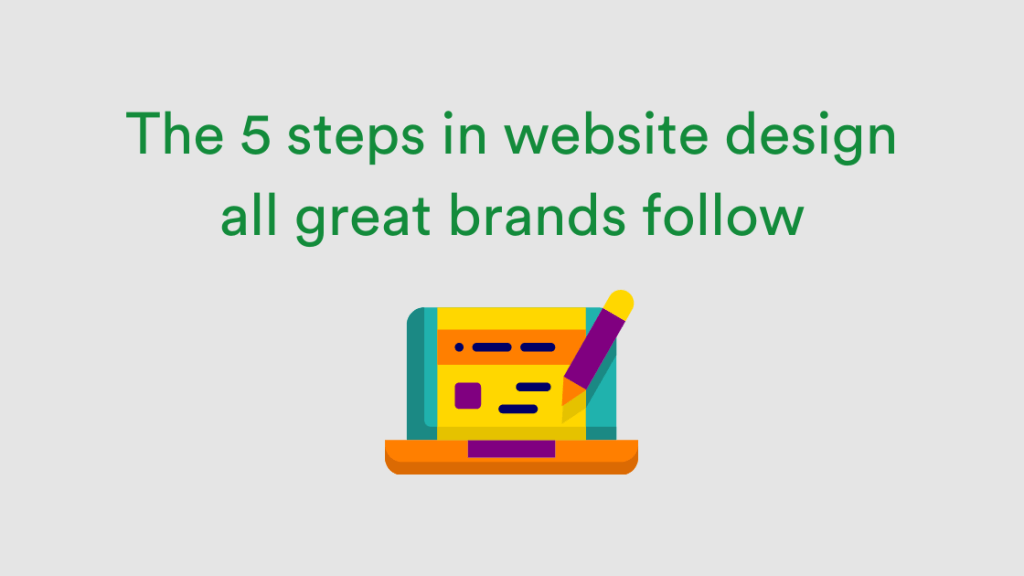
To design websites users will love, it’s essential to seamlessly connect every phase of web design. A properly structured web design process will help you create intuitive products, as well as improving collaboration between you and your design team – meaning less headaches and more high fives.
You can summarize website design in five major phases:
- Planning & ideation
- Layout & wireframe
- Visual design & prototyping
- Staging
- Launch
Let’s go deeper into what each phase includes.
Phase 1: Planning & ideation
Your website design journey starts with defining the goals and objectives of the site. At this discovery phase, you and your design team meet to gain an understanding of your particular niche or industry, define your product’s unique value proposition, and learn about your customer segments. At the crux of this, lies clearly defining the purpose of your website.
To create the project plan, it is crucial to make a checklist to clearly identify roles, actions, and timelines within a project. There are a lot of people involved in launching a website: you have marketers writing the content; designers choosing images and laying out the overall look and feel; a technical team doing development. A clear plan is imperative to your success.
Popular project planning tools include:
Finally, concept ideation can begin. UX and UI designers will build on ideas selected from the discovery phase for review and testing.
Phase 2: Sitemap & wireframe
The second step in website design is to create a sitemap that provides a clear picture of a website’s structure, information architecture, as well as explain the relationships between the various pages and content elements. It is a kind of table of contents outlining what pages relate to which content on a website. A sitemap allows users to see the layout of your pages and the order of their hierarchy.
A wireframe, instead, is a visual design blueprint of what your site will look like and is used by designers before the website is created. This allows you to add your content ideas into a structured presentation. It helps you organize and simplify the elements and content within a space (web or mobile) and can help identify potential challenges and gaps with the sitemap.
Wireframes handle structure, mockups handle visuals, and prototypes handle usablity.
Phase 3: Visual design & prototyping
The next step in the creation process is to decide on a visual design for your website. There are a number of popular tools that can help you with this phase. Some favorite design mockup tools are:
Most website design platforms offer a choice of templates or themes that determine the basic appearance of your site. Of course, you always have the option of creating a custom design from scratch. Check our article on 10 stunning websites using WordPress for design inspiration.
You will need to add your branding and select imagery to complete your design and ensure that it stands out.
Prototyping
Prototyping allows designers to develop and test a website in a real-life scenario. It will show you how users will interact with your site, how they might move between different actions or tasks. Ultimately prototyping is a tool to test and improve the usability of a site and ensure that your design is delivering the goal of your website.
Some popular prototyping tools include:
Phase 4: Staging
A staging website acts as the bridge between the development and live versions of your site. To put it simply, it is a draft of your live website. It enables you to test any changes or major new features that you plan to implement in a secure environment.
During the staging phase, it is essential that you are happy with the balance between the form and function of your site. You need to ensure that the branding, design, and content reflect your brand purpose, but it is equally as important that the way people navigate and experience your site is intuitive.
At this point, any remaining errors should be addressed, responsiveness and browser compatibility checked, and the changes should be ready to roll out for launch. Developers also use a staging phase to fix bugs before going to production.
Phase 5: Launch
Time to launch your site! Although it is important to understand that web design is a fluid and ongoing process that requires constant maintenance, and feedback loops from site visitors. Once the site goes live, you can continually run user testing on new content and features, monitor analytics, and refine your messaging.
Following these five seamless steps, helps ensure that your website design is intuitive for users – and best of all you and your design teams have collaborated seamlessly to ensure the right balance of form and function.